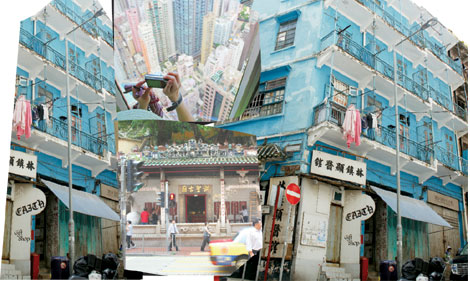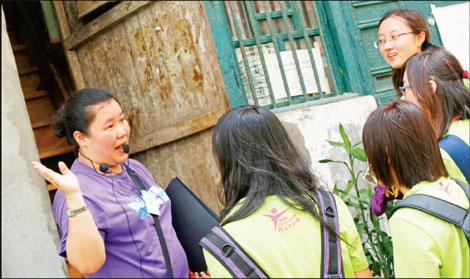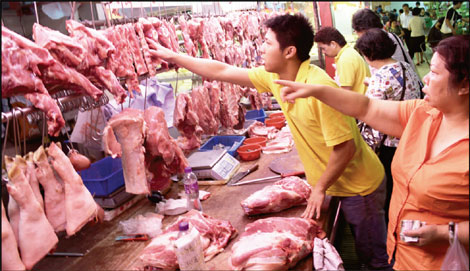In Wan Chai, heritage lives in a Blue House
Updated: 2010-08-24 07:26
By Doug Meigs(HK Edition)
|
|||||||
|
The Blue House is a preserved Grade-I heritage site that is home to a community museum and a handful of long-time residents. Provided to China Daily |
|
Hua Zeng-Jie is a resident tour guide in Wan Chai. She explains the history of the Blue House to youths. Provided to China Daily |
|
A woman buys meat at the (New) Wanchai Market, which replaced the historic Wanchai Market in 2008. Developers are building a skyscraper atop the old market. Provided to China Daily |
A small museum helps Wan Chai residents to guide visitors, past wet markets and construction sites, into the district's living heritage. Doug Meigs reports.
T ong lau and airplane olives used to be commonplace in Vincent Ho Wai-Sun's neighborhood. Ho was born in Wan Chai, and he spent much of his 62 years in the district.
Now, the retired accountant spends his leisure hours training to become a guide for the Wanchai Livelihood Place.
The museum features a rotation of exhibits dedicated to grassroots culture. Tours allow local residents to share their personal stories with visitors from Hong Kong and abroad.
Wanchai Livelihood Place is located at 74 Stone Nullah Lane, in the ground floor of the Blue House that is a government-designated Grade 1 heritage site. Built in the 1920s, the Blue House exemplifies Hong Kong's old tong lau architecture. The word tong lau translates to "tenement house."
The buildings were common commercial and residential constructions in Hong Kong until the 1960s. Typically no more than four stories tall, they featured balconies and partitioned rooms with high-rise bunk beds, where families crammed into close quarters - sometimes 20 people to a room.
Ho lived in a tong lau as a child. So did his neighbors. He remembers when the district was mostly residential.
His recollections long predate local heritage controversies, which began raging with the destruction of Star Ferry Pier in Central District in 2006.
Preserving Wan Chai's physical heritage is only part of the mission of Livelihood Place. The museum's primary focus is exploring how heritage intersects with daily life, said Suki Chau Hei-Suen.
"We train the residents because we think they are the ones that know Wan Chai most," Chau said. "Rather than having them memorize facts and figures, we help them organize their stories so they can share them."
She and other staff meet regularly with local residents for feedback on neighborhood preservation and revitalization plans.
Chau is the team leader at the Blue House. She works for the St. James Settlement, a non-profit community organization that specializes in empowering disadvantaged people.
Not only does the Livelihood Place provide a base of operations for local tour guides, it is home to a handful of long-term residents (including a doctor who studied kung fu from the legendary Wong Fei-hung).
Chau is among many conservationists who fault the government for responding too late to the community's preservation needs.
Ho, on the other hand, is optimistic. "Better late than never," he said.
He has volunteered with the St. James Settlement for many years and became a trainee at the Livelihood Place to help locals remember the heritage sacrificed to Wan Chai's elevated skyline.
The Livelihood Place and St. James Settlement have trained roughly 24 tour guides since 2005, four years before the government finally established the Wanchai Heritage Trail. The community museum moved into the Blue House in January 2007.
Ho is among the third batch of guides to receive training, and he plans to begin leading tours this year.
The first two batches were geared toward community outreach, Chau said, and the third batch is focused on employment, with financial sponsorship coming from the Swire Group, a powerful real estate developer headquartered in Hong Kong.
"Many of the guides used to be grassroots people, housewives, former factory workers, or people receiving government support, but this third batch of trainees has a more stable economic background," she said.
Ho left Wan Chai when he was six years old. He later rented a few apartments in the area. After residing in Australia for a time, he returned permanently to the neighborhood in 1991.
He is especially nostalgic about the food hawkers, many of which disappeared during his absence. He especially misses the once-common olive vendors.
During a Livelihood Place tour last week, another longtime Wan Chai resident guide reminisced about the olives - fei gei larm or "airplane olives" - that hawkers lobbed up to customers waving on tong lau balconies.
Hua Zeng-Jei spoke in Mandarin to a group from various Chinese territories. Youths from across the mainland, Macao, Taiwan and Hong Kong listened attentively. Hua is originally from the countryside of the mainland, but has made Wan Chai her home since the 80s.
The tour group stood across the street from the Blue House, where Hua said the hawkers used to throw "airplane olives" as high as the fourth floor. Not every throw was accurate. Customers only paid for the olives they caught, she said, and they tossed down payment accordingly.
She took the tour to various redevelopment sites, including the Nam Koo Terrace, an old mansion supposedly haunted by ghosts of "comfort women" who committed suicide during the Japanese military's occupation of Hong Kong in World War II. The mansion is undergoing a massive renovation that should be complete by 2014.
They also visited the Hopewell Center, the tallest building in Hong Kong between 1980-89, where the youths snapped photos from the viewing elevator. Far down, at ground level, construction workers scurried like ants over a gaping hole that will become the 55-storey Hopewell Center II.
At the (New) Wanchai Market, Hua lambasted developers while standing in the modern, air-conditioned structure.
"Developers haven't come for my building yet, but if they do, maybe I'll have to move to New Territories," she said. "For many of the old residents, it's especially difficult to pick up and start a new life so far away."
Across the street, a facade is all that remains of the (Old) Wanchai Market. New construction has begun atop the ransacked heritage site. A luxury residential complex will soon tower over the neighborhood - carrying real estate values and rental costs skyward with it.
Hua speaks passionately about preservation in Wan Chai, and she enjoys being a tour guide.
"Young people nowadays don't know what happened in the past, but they need to; this job makes me feel confident about it," she said.
Residents offer a personalized glimpse at local heritage that is impossible to see in the static, macro perspective of traditional museums, said tour guide Cheang Yee-Lap.
Cheang would know. He was a teacher at the Hong Kong Museum of History before coming to the Livelihood Place.
The community museum offers a slew of tour options in different languages (generally tailored to the skills and interests of the guide), with topics ranging from cultural stories, to local eateries, and the popular "Ghosts and the Ghostly Routes."
"I'm interested in everything, so I've led just about all the tours," Cheang said.
The Livelihood Place receives 2,000 visitors per month. By the end of August, the museum will unveil new tour itineraries in English, Cantonese and Mandarin, with tours in Central District for the first time.
(HK Edition 08/24/2010 page4)


